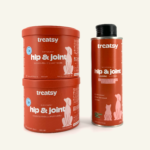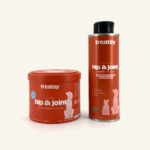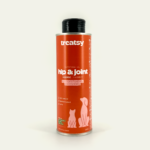Several studies reveal that osteoarthrosis affects approximately 20% of adult dogs. It is estimated that more than 15 million dogs in Europe suffer from hip and joint disorders. Some breeds are more likely to suffer from it than others. Bulldogs, Spaniels, Mastiffs and Pugs are prone to dysplasia. Rottweilers, Labradors, Golden Retrievers, Shepherds and Shetlands also regularly suffer from osteoarthrosis.
osteoarthrosis and mobility problems are the leading cause of chronic pain in dogs, and more than a third of owners say their dog has had bone and joint problems during their life.
Several factors influence the risk of mobility disorders:
- Age
- Breed: Larger, faster-growing breeds are generally more prone to osteoarthrosis
- Genetics
- Injuries
- Obesity
Does your dog have difficulty climbing stairs, walking or jumping? Is he limping, playing less than before, or resting a lot more than before? In this case, he may suffer from mobility problems.
If he suffers from hip dysplasia or has had surgery for a fracture, special attention is needed to avoid mobility problems in the future.
How to reduce the risk of mobility disorders and support the dog’s joints?
The most effective way to prevent mobility disorders is to prevent your dog from becoming overweight or obese.
Obese dogs are more prone to mobility issues, because excess weight causes excessive load on the joints, leading to increased wear of cartilage and synovial fluid, and therefore an increased risk of developing osteoarthrosis.
Additionally, providing your dog with a high-quality diet that provides the right nutrients needed to maintain joint health will help prevent future mobility problems. Here are some nutrients and ingredients with scientifically proven benefits that are essential for maintaining or improving joint health:
- Omega-3 essential fatty acids, which fight against joint inflammation thanks to EPA and DHA, and which help combat pain and cartilage degradation.
- Chondroitin sulfate & glucosamine: these are specific protectors of cartilage called chondroprotectors. In certain cases, they enable to reduce the doses of anti-inflammatory medication administered at the same time.
- Collagen: type 1 collagen helps strengthen your dog’s connective tissues (especially tendons and ligaments), thus supporting its joint stability. Type 2 collagen is one of the main building blocks of cartilage. It is effective in relieving pain and seems to be even more effective when combined with glucosamine. These 2 types of collagens also help reduce the impact of aggrecanases on cartilage and reduce the signs of osteoarthrosis.
- Green-lipped mussel: this marine source is rich in glycosaminoglycans (GAGs) and essential Omega-3 fatty acids. It has anti-inflammatory properties and helps reduce certain symptoms of mobility disorders.
- Hyaluronic acid: is naturally present in cartilage. Combined with other glycosaminoglycans and nutrients, it helps to lubricate the joint and ensures nutrition of the cartilage and its resistance to compression.
- Devil’s Claw (Harpagophytum procumbens): this South African medicinal plant is well known in human health and has strong anti-inflammatory properties. It is rich in iridoids, a family of substances that block the synthesis of compounds that generate inflammation. According to several studies in humans, Harpagophytum reduces joint stiffness in subjects suffering from osteoarthrosis.
- Turmeric: contains active nutrients with anti-inflammatory properties.
- MSM (Methylsulfonylmethane): this is a sulfur compound present in very small quantities in many foods (fruits, vegetables, cereals, milk, algae, meat, seafood, etc.). Human clinical studies have shown encouraging results regarding the contribution of MSM to the health of connective tissues (tendons, collagen, and cartilage), thanks to the sulfur it contains.
- Certain vitamins such as vitamin D.
In addition to being sometimes difficult to obtain, all these ingredients and nutrients are expensive for manufacturers, so they are very rarely present in a standard diet.
However, your veterinarian can recommend a therapeutic food that will contain some of these nutrients or ingredients and will promote your dog’s mobility.
Furthermore, you’ll find a high concentration of these ingredients and nutrients with scientifically proven benefits in supplements such as Treatsy Hip & Joint chews. Next to that, oils rich in Omega-3, EPA and DHA, such as Treatsy Hip & Joint Oil, are also one of the most effective ways to improve dog mobility naturally.



